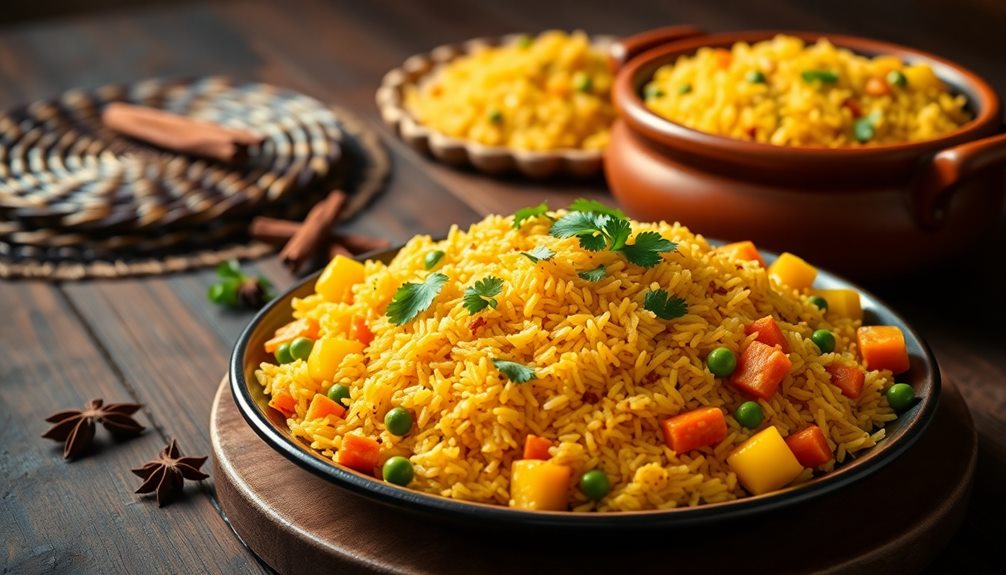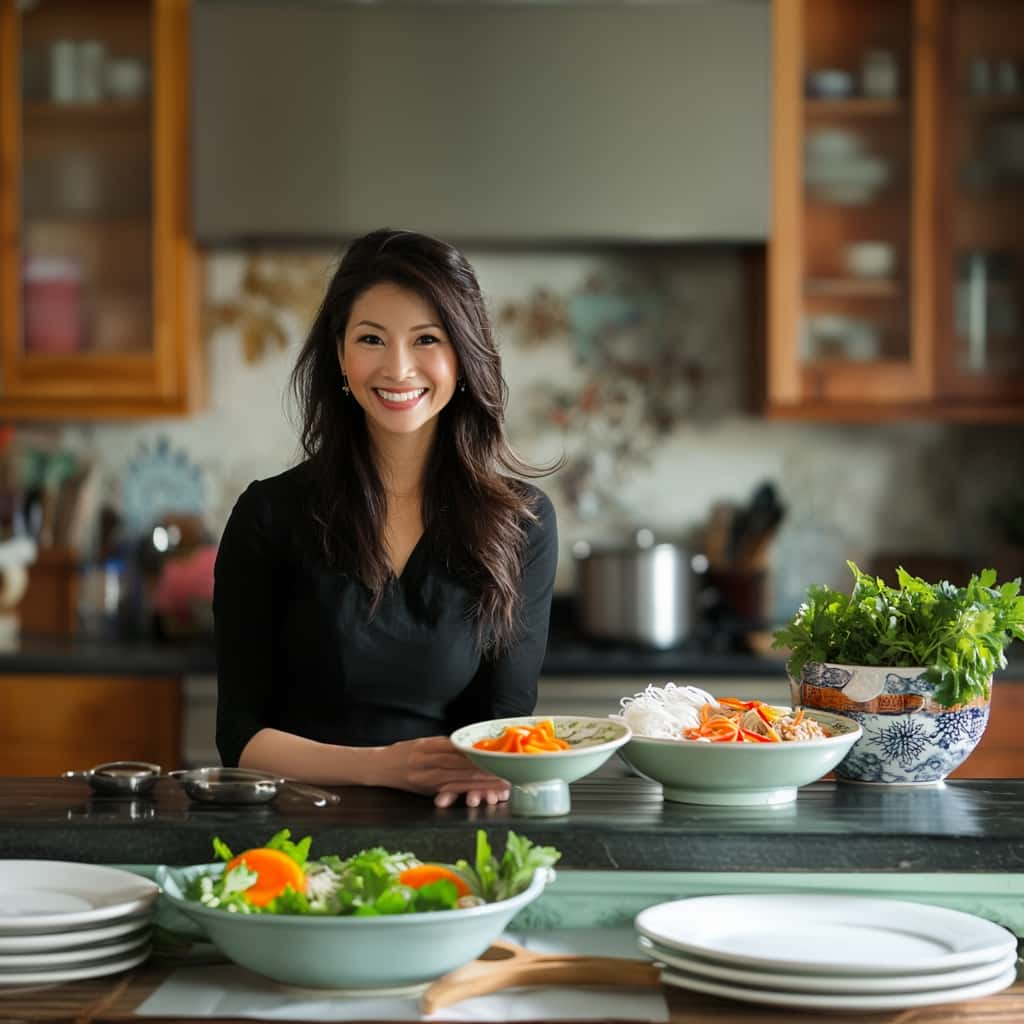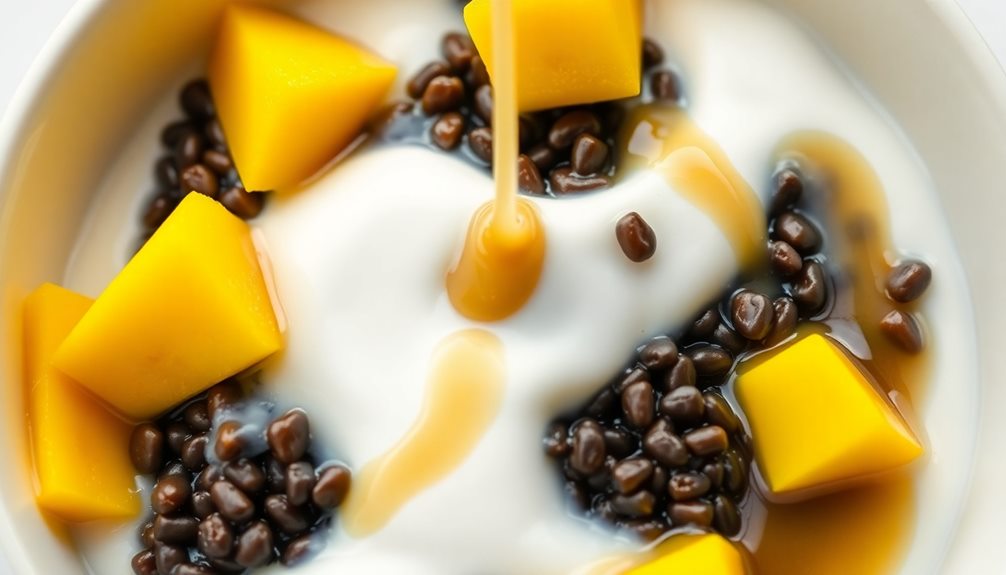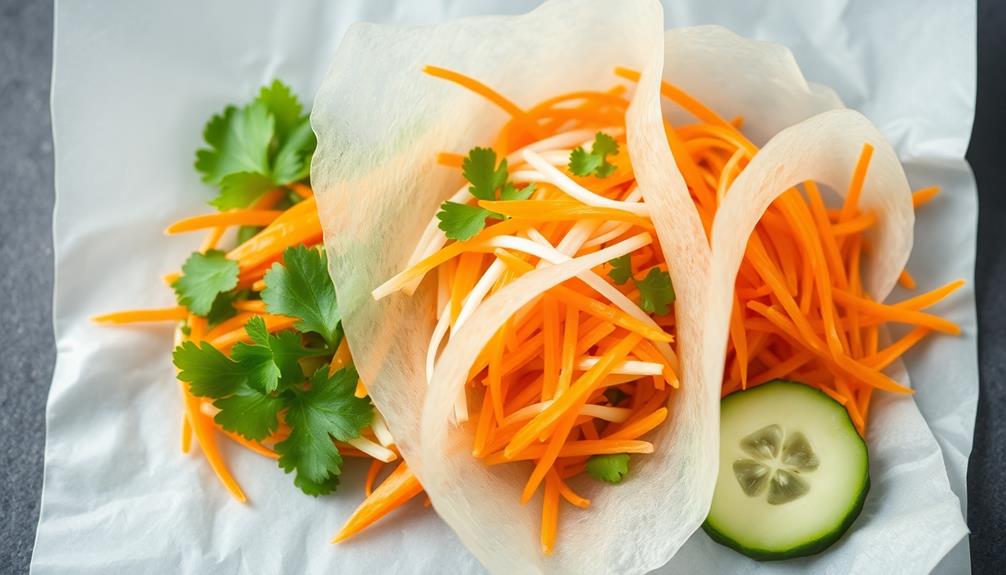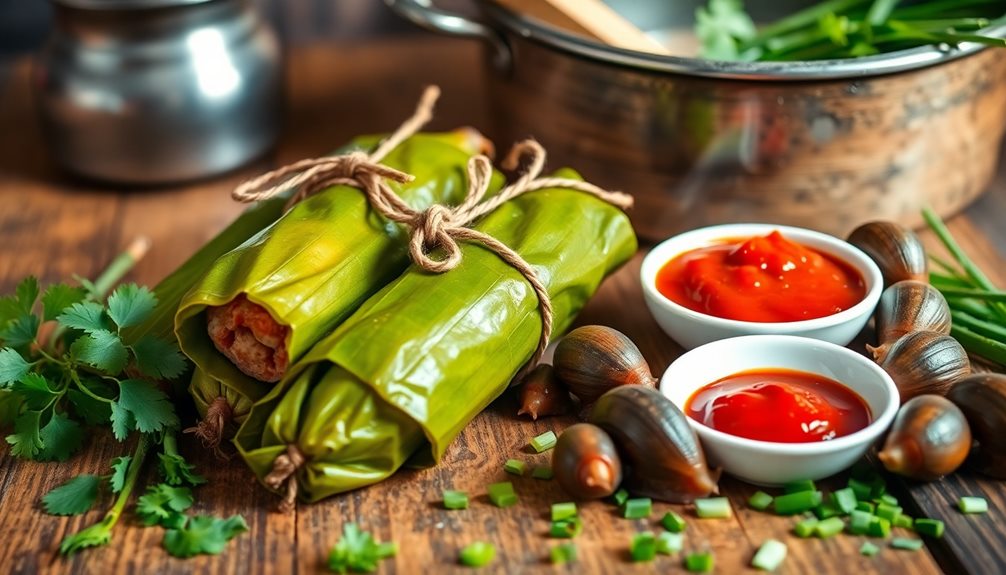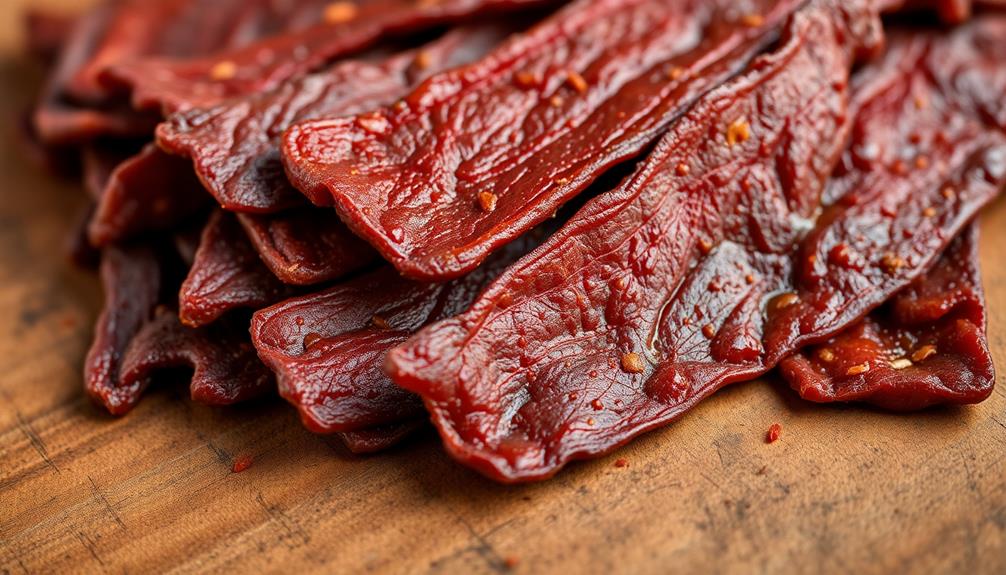Celebrate Vietnam's cultural heritage by enjoying the beloved Bánh Chưng, a traditional rice cake that's been gracing Lunar New Year festivities for centuries. This legendary dish has roots dating back to the 6th century BC, symbolizing the harmony of earth and sky. Today, families come together to carefully craft these tasty bundles, wrapping glutinous rice, mung beans, and pork in fragrant banana leaves. Preparing Bánh Chưng is a labor of love, but the result is a delicious treat that brings people closer and preserves cherished traditions. Keep reading to discover the fascinating history and mouthwatering preparation of this iconic Vietnamese delight.
Key Takeaways
- Bánh Chưng is a traditional Vietnamese rice cake deeply rooted in the country's cultural heritage, dating back to the 6th century BC.
- The dish symbolizes the harmony and balance of nature, with its square shape representing the earth and sky.
- Preparing Bánh Chưng involves family collaboration, reflecting the agricultural lifestyle and seasonal cycles of Vietnam.
- Bánh Chưng serves as a symbol of family unity and shared memories, particularly during the Lunar New Year celebrations.
- Contemporary adaptations of Bánh Chưng maintain traditional methods while embracing innovation, ensuring the dish's cultural significance endures.
History

Bánh Chưng, Vietnam's iconic rice cake, has its roots firmly planted in the nation's rich cultural heritage. This beloved delicacy has been a cherished part of Vietnamese celebrations for centuries, with its origins tracing back to the legendary story of Vương Thế Bửu.
During the Hùng Kings era, Vương Thế Bửu created the square-shaped Bánh Chưng to represent the earth, and the round Bánh Tết to symbolize the sky. These cakes became symbols of harmony and balance, reflecting the deep connection between the Vietnamese people and their natural world.
Today, the preparation of Bánh Chưng remains a labor of love, with families coming together to meticulously wrap the glutinous rice, mung bean, and pork filling in fragrant banana leaves.
The intricate folding and tying techniques have been passed down through generations, preserving the traditions that make this rice cake so special.
Recipe

Bánh Chưng, a traditional Vietnamese rice cake, has been a beloved part of Vietnamese culture for centuries. This savory and filling dish is typically made during the Lunar New Year, or Tết, celebration, but can be enjoyed year-round.
The process of making Bánh Chưng is a labor of love, requiring patience and attention to detail. The end result, however, is a delectable treat that perfectly encapsulates the flavors and traditions of Vietnam.
Ingredients:
- 2 cups glutinous rice
- 1 pound pork shoulder, cubed
- 1 cup mung bean, soaked and peeled
- 2 tablespoons fish sauce
- 1 teaspoon black pepper
- 1 teaspoon salt
- 4 banana leaves, cut into 12-inch squares
- Twine or bamboo skewers
Cooking Instructions:
Mix the glutinous rice, pork, mung bean, fish sauce, black pepper, and salt in a large bowl until well combined.
Place a banana leaf square shiny-side down on a flat surface. Scoop a portion of the rice mixture onto the center of the leaf and fold the sides over the filling, then fold the top and bottom to create a square packet. Secure the packet with twine or bamboo skewers.
Extra Tips:
It's important to soak the banana leaves in water for 30 minutes before using to make them pliable and easy to work with.
Additionally, the Bánh Chưng should be steamed for at least 12 hours to ensure the rice is cooked through and the flavors have fully developed. Enjoy this traditional Vietnamese delicacy with family and friends.
Cooking Steps

Soak the glutinous rice overnight to soften it up.
Then, wrap the rice in fragrant leaves and tie the bundles with bamboo strings.
Step 1. Soak Glutinous Rice Overnight
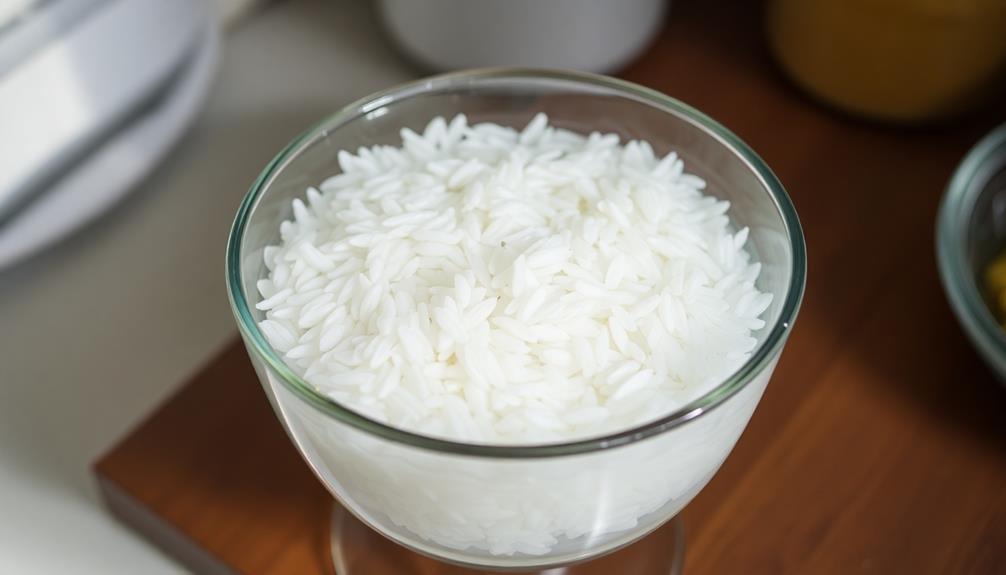
Soaking the glutinous rice overnight is a crucial first step in crafting the beloved Bánh Chưng. This simple yet vital process allows the rice to absorb water, softening it in preparation for the next stages.
Start by rinsing the rice thoroughly, removing any impurities. Then, place the rice in a large bowl and cover it with clean water. Let it sit overnight, giving the grains ample time to soak up the moisture.
Come morning, you'll notice the rice has expanded, becoming plump and hydrated – perfect for the next steps in Bánh Chưng assembly.
Soaking the rice is an essential foundation, ensuring the cake holds together beautifully and cooks evenly. With this simple task complete, you're one step closer to enjoying the festive flavor and texture of this cherished Vietnamese delicacy.
Step 2. Wrap Glutinous Rice Bundles in Leaves

With the glutinous rice soaked and ready, you can now move on to wrapping the rice bundles in leaves.
First, take a large, sturdy leaf, such as banana or bamboo leaves. Place a handful of the soaked glutinous rice in the center of the leaf. Fold the sides of the leaf over the rice, then roll it up tightly, creating a compact, rectangular bundle. Secure the bundle with twine or thin strips of the leaf.
Repeat this process until you've used up all the rice.
The leaves not only hold the rice together but also impart a lovely, earthy flavor as the bundles steam. As you wrap each one, be sure to press the rice firmly to avoid any gaps or air pockets. This will help the cakes hold their shape during the cooking process.
With your rice bundles all wrapped up, you're now ready to cook them to perfection!
Step 3. Tie Bundles With Bamboo Strings
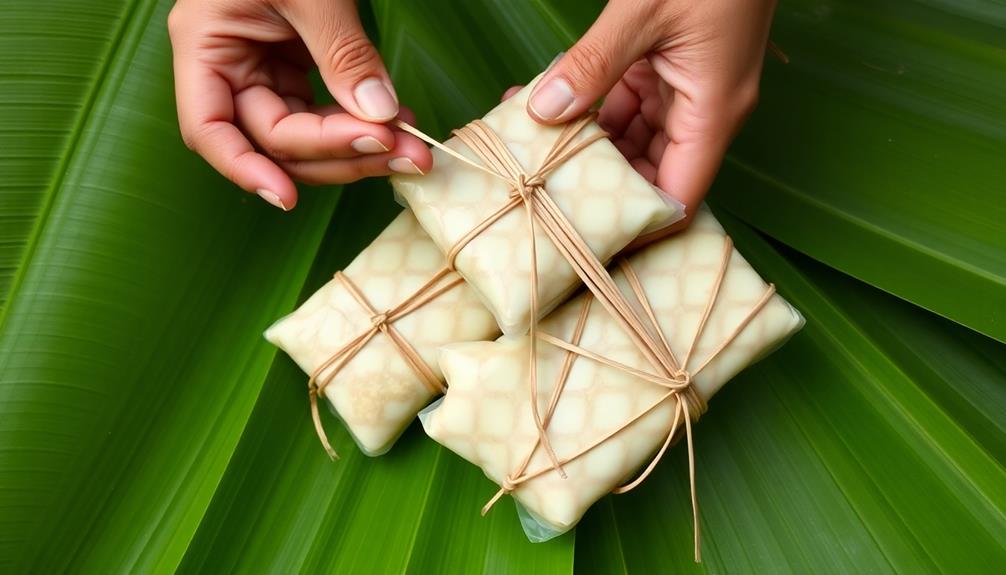
Once your glutinous rice bundles are wrapped in the leaves, you'll need to tie them up securely with bamboo strings. This step is crucial to ensure the banh chung holds its shape during the long cooking process.
First, take a length of flexible bamboo string and wrap it around the center of the leaf-wrapped bundle. Tie the string tightly, creating a secure knot. Then, continue wrapping the string around the bundle, crisscrossing it to form an "X" pattern. Make sure to cover the entire surface, tying the string at the ends to keep everything in place.
Next, you can add additional layers of string if needed, criss-crossing in different directions to reinforce the bundle. The goal is to create a tight, sturdy package that won't unravel during boiling.
With the bundles securely tied, they're ready to be cooked and transformed into the beloved banh chung.
Step 4. Cook the Bundles

The bundles, now securely tied, are ready to be cooked. First, choose a large pot or wok and fill it with water, making sure the water level is high enough to fully submerge the rice bundles. Bring the water to a boil over high heat.
Carefully lower the tied bundles into the boiling water, ensuring they're completely submerged. Reduce the heat to maintain a gentle simmer. Cover the pot with a lid and let the bundles cook for 4-5 hours, turning them occasionally to ensure even cooking.
As the bundles cook, the sticky rice will become soft and aromatic. The bamboo leaves will also infuse the rice with a subtle, earthy flavor. Keep an eye on the water level, adding more as needed to prevent the bundles from drying out.
Once the bundles are thoroughly cooked, use tongs or a slotted spoon to carefully remove them from the pot. Allow them to cool slightly before serving. The delicious bánh chưng is now ready to be enjoyed!
Step 5. Unwrap and Serve Bánh ChưNg

After the rice bundles have finished cooking, it's time to unwrap and serve the delicious bánh chưng. Gather your family and friends, as this is a joyous occasion!
Carefully remove the leaves, revealing the green-tinged rice cakes inside. The aroma of savory pork, mung beans, and fragrant leaves will fill the air, making mouths water in anticipation.
Slice the bánh chưng into thick, satisfying pieces. The sticky rice should have a soft, pillowy texture, while the fillings provide a delightful contrast of flavors. Serve the slices on a platter, garnished with fresh herbs if desired.
Don't forget the accompanying dipping sauces – the sweet and salty flavors will complement the bánh chưng perfectly.
As you gather around the table, share stories and laughter while savoring this beloved Vietnamese tradition. Celebrate the new year or any special occasion with the comforting and nourishing bánh chưng.
Enjoy every bite, for this is a truly special moment to cherish.
Final Thoughts
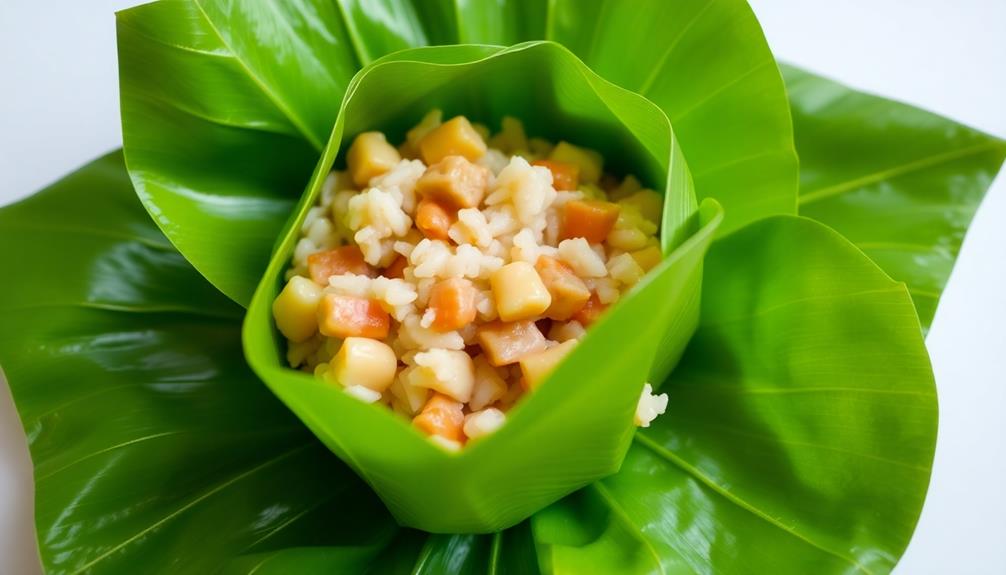
Ultimately, banh chung remains a treasured part of Vietnamese culinary heritage, transcending mere sustenance to embody cultural identity and cherished traditions.
This delightful rice cake, wrapped in fragrant banana leaves, is the centerpiece of Lunar New Year celebrations, bringing families together to savor its rich flavors and bask in the warmth of shared memories.
Whether served hot off the steamer or enjoyed as a snack throughout the year, banh chung represents the ingenuity and resilience of the Vietnamese people.
Its layers of sticky rice, savory pork, and mung bean evoke the harmony of nature and the enduring spirit of the nation.
As you unwrap this edible embodiment of Vietnamese culture, let it inspire a renewed appreciation for the timeless traditions that continue to shape and nourish the hearts of the people.
Banh chung, a delicious bridge between past and present, is a true celebration of Vietnam's vibrant heritage.
Frequently Asked Questions
How Long Does It Take to Make Bánh ChưNg?
Making bánh chưng takes time and effort, as it's a labor-intensive process. Typically, it can take around 8-12 hours to prepare and cook the rice cake, depending on your experience and the scale of production.
Where Can I Buy the Ingredients for Bánh ChưNg?
You can find the ingredients for bánh chưng at Asian grocery stores or specialty Vietnamese markets. Look for sticky rice, mung beans, pork, and banana leaves. Many stores now sell pre-made bánh chưng for convenience.
Is Bánh ChưNg Gluten-Free?
Yes, bánh chưng is gluten-free. This traditional Vietnamese rice cake is made from glutinous rice, mung beans, and pork, without any wheat flour or other gluten-containing ingredients. It's a safe option for those following a gluten-free diet.
How Do You Store Leftover Bánh ChưNg?
To store leftover bánh chưng, you can wrap it in plastic or store it in an airtight container in the fridge for up to a week. Reheat it before serving to enjoy its fresh flavor.
Can I Make Bánh ChưNg With Instant Rice?
You can't make bánh chưng with instant rice. The traditional rice cake requires glutinous rice, which has a different texture and binding properties than instant rice. Trying to use instant rice won't give you the authentic bánh chưng experience.

